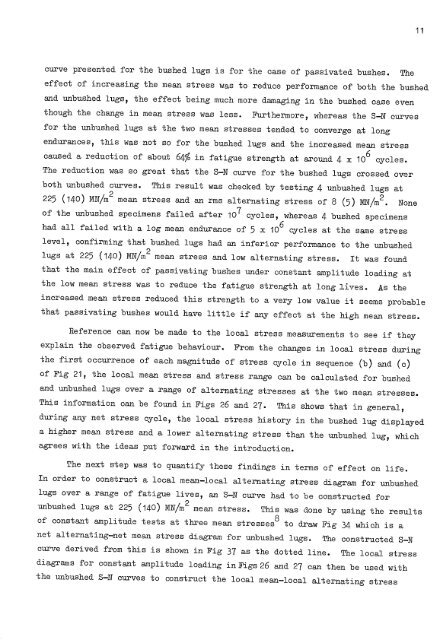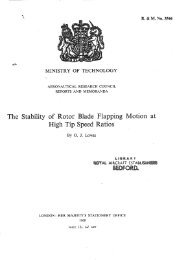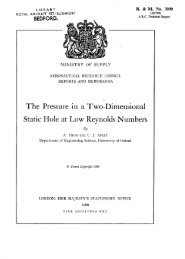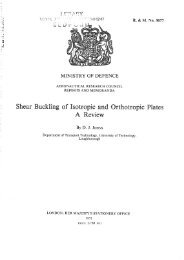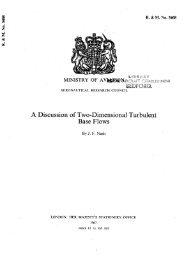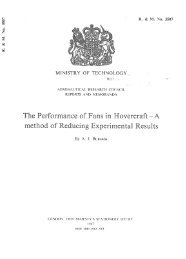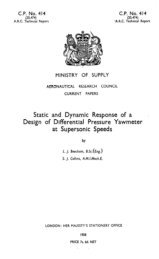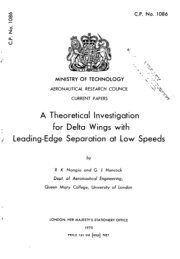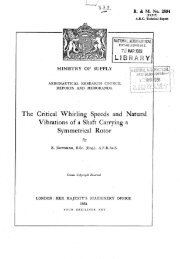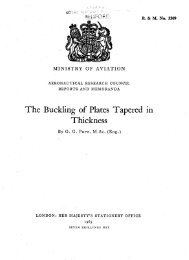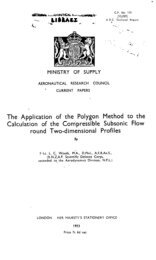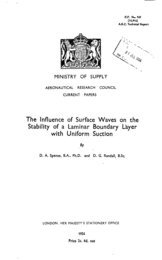Fatigue behaviour of BS 2L65 aluminium alloy pin - aerade
Fatigue behaviour of BS 2L65 aluminium alloy pin - aerade
Fatigue behaviour of BS 2L65 aluminium alloy pin - aerade
Create successful ePaper yourself
Turn your PDF publications into a flip-book with our unique Google optimized e-Paper software.
curve presented for the bushed lugs is for the case <strong>of</strong> passivated bushes. The<br />
effect <strong>of</strong> increasing the mean stress was to reduce performance <strong>of</strong> both the bushed<br />
and unbushed lugs, the effect being much more damaging in the bushed case even<br />
though the change in mean stress was less. Furthermore, whereas the S-N curves<br />
for the unbushed lugs at the two mean stresses tended to converge at long<br />
endurances, this was not so for the bushed lugs and the increased mean stress<br />
caused a reduction <strong>of</strong> about 64% in fatigue strength at around 4 x 106 cycles.<br />
The reduction was so great that the S-N curve for the bushed lugs crossed over<br />
both unbushed curves. This result was checked by testing 4 unbushed lugs at<br />
225 (140) MN/m 2 mean stress and an rms alternating stress <strong>of</strong> 8 (5) MN/m 2. None<br />
<strong>of</strong> the unbushed specimens failed after 107 cycles, whereas 4 bushed specimens<br />
had all failed with a log mean endurance <strong>of</strong> 5 x 106 cycles at the same stress<br />
level, confirming that bushed lugs had an inferior performance to the unbushed<br />
lugs at 225 (140) MN/m 2 mean stress and low alternating stress. It was found<br />
that the main effect <strong>of</strong> passivating bushes under constant amplitude loading at<br />
the low mean stress was to reduce the fatigue strength at long lives. As the<br />
increased mean stress reduced this strength to a very low value it seems probable<br />
that passivating bushes would have little if any effect at the high mean stress.<br />
Reference can now be made to the local stress measurements to see if they<br />
explain the observed fatigue <strong>behaviour</strong>. From the changes in local stress during<br />
the first occurrence <strong>of</strong> each magnitude <strong>of</strong> stress cycle in sequence (b) and (c)<br />
<strong>of</strong> Fig 21~ the local mean stress and stress range can be calculated for bushed<br />
and unbushed lugs over a range <strong>of</strong> alternating stresses at the two mean stresses.<br />
This information can be found in Figs 26 and 27. This shows that in general,<br />
during any net stress cycle, the local stress history in the bushed lug displayed<br />
a higher mean stress and a lower alternating stress than the unbushed lug, which<br />
agrees with the ideas put forward in the introduction.<br />
The next step was to quantify these findings in terms <strong>of</strong> effect on life.<br />
In order to construct a local mean-local alternating stress diagram for unbushed<br />
lugs over a range <strong>of</strong> fatigue lives, an S-N curve had to be constructed for<br />
unbushed lugs at 225 (140) MN/m 2 mean stress. This was done by using the results<br />
<strong>of</strong> constant amplitude tests at three mean stresses 8 to draw Fig 34 which is a<br />
net alternating-net mean stress diagram for unbushed lugs. The constructed S-N<br />
curve derived from this is shown in Fig 37 as the dotted line. The local stress<br />
diagrams for constant amplitude loading in Figs 26 and 27 can then be used with<br />
the unbushed S-N curves to construct the local mean-local alternating stress<br />
11


